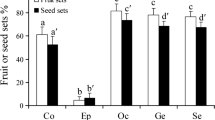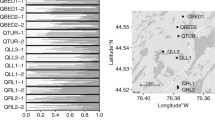Abstract
Stenocereus eruca is a prostrated, self-incompatible cactus endemic to the Sonoran Desert that regenerates primarily through clonal propagation. Clonal growth is expected to affect mate availability by influencing the number and spatial distribution of mating types. In this paper we examine the role of clonal growth on female fecundity through a series of pollination experiments in a population of S. eruca. We set up a pollen supplementation experiment using five distance treatments with pollen collected at 1, 10, 100, 1000 and 25000 m from receptor flowers during the years 2001 and 2002 and evaluated genetic sifmilarities between pairs of receptor-donor ramets through RAPD markers. Our data on fruit set, number of seeds/fruit, germination and overall fecundity revealed that S. eruca show a significant reduction in female fecundity when pollination occurs between ramets located at short distances (1 and 10 m), while genetic data showed high levels of similarity at those distances. The reduction in female fecundity is apparently a consequence of geitonogamy and inbreeding depression. Our data suggest that clonal growth and geitonogamy are likely to be partially responsible for the low levels of sexual reproduction and seedling recruitment observed in populations of S. eruca.
Similar content being viewed by others
References
T.H. Boyle (1997) ArticleTitleThe genetics of self-incompatibility in the genus Schlumbergera (Cactaceae) J. Heredity 88 209–214
T.H. Boyle (2003) ArticleTitleIdentification of self-incompatibility groups in Hatiora and Schlumbergera (Cactaceae) Sex. Plant Reprod. 16 151–155 Occurrence Handle10.1007/s00497-003-0187-3
H. Bravo-Hollis (1978) Las cactáceas de México Universidad Nacional Autónoma de México México, D.F, México
J.L. Brewbaker (1967) ArticleTitleThe distribution and phylogenetic significance of binucleate and trinucleate pollen grains in the angiosperms Am. J. Bot. 54 1069–1083
D.L. Byers T.R. Meagher (1992) ArticleTitleMate availability in small populations of plant species with homomorphic sporophytic self-incompatibility Heredity 68 353–359
V. Castric X. Vekemans (2004) ArticleTitlePlant self-incompatibility in natural populations: a critical assessment of recent theoretical and empirical advances Mol. Ecol. 13 2873–2889 Occurrence Handle1:CAS:528:DC%2BD2cXptFSktbg%3D Occurrence Handle15367105
A. Charpentier P. Grillas D.J. Thompson (2000) ArticleTitleThe effects of population size limitation on fecundity in mosaic populations of the clonal macrophyte Scirpus maritimus (Cyperaceae) Am. J. Bot. 87 502–507 Occurrence Handle10766721
A. Charpentier (2002) ArticleTitleConsequences of clonal growth for plant mating Evol. Ecol. 15 521–530
R. Clark-Tapia F. Molina-Freaner (2004) ArticleTitleReproductive ecology of the rare clonal cactus Stenocereus eruca in the Sonoran desert Plant Syst. Evol. 247 155–164 Occurrence Handle10.1007/s00606-003-0118-7
R. Clark-Tapia C. Alfonso-Corrado L. Eguiarte F. Molina-Freaner (2005a) ArticleTitleClonal diversity and distribution in Stenocereus eruca, a narrow endemic cactus of the Sonoran desert Am. J. Bot. 92 272–278
R. Clark-Tapia M.C. Mandujano T. Valverde A. Mendoza F. Molina-Freaner (2005b) ArticleTitleHow important is clonal recruitment for population maintenance in rare plant species?: the case of the narrow endemic cactus, Stenocereus eruca, in Baja California, México Biol. Conserv. 124 123–132
D. Nettancourt ParticleDe (2001) Incompatibility and Incongruity in Wild and Cultivated Plants EditionNumber2 Springer-Verlag Berlin, Germany
O. Eriksson (1993) ArticleTitleDynamics of genets in clonal plants Trends Ecol. Evol. 8 313–316 Occurrence Handle10.1016/0169-5347(93)90237-J
F.R. Ganders (1976) ArticleTitleSelf-incompatibility in the Cactaceae Cactus Succulent J. 38 39–40
A.C. Gibson (1989) ArticleTitleThe systematics and evolution of subtribe Stenocereinae. 7. The Machaerocerei of Stenocereus Cactus Succulent. J. 61 104–112
S.N. Handel (1985) ArticleTitleThe intrusion of clonal growth patterns on plants breeding systems Am. Nat. 125 367–384 Occurrence Handle10.1086/284348
B. Jones C. Gliddon (1999) ArticleTitleReproductive biology and genetic structure in Lloydia serotina Plant Ecol. 141 151–161 Occurrence Handle10.1023/A:1009805401483
M.J. Lawrence (2000) ArticleTitlePopulation genetics of the homomorphic self-incompatibility polymorphisms in flowering plants Ann. Bot. 85 221–226 Occurrence Handle10.1006/anbo.1999.1044
F. Molina-Freaner R. Clark-Tapia (2005) ArticleTitleClonal diversity and allelic relationship among two closely related species of columnar cacti from the Sonoran desert: Stenocereus eruca and S. gummosus Int. J. Plant Sci. 166 257–264 Occurrence Handle10.1086/427486
M. Nei W.H. Li (1979) ArticleTitleMathematical model for studying genetic variation in terms of restriction endonucleases Proc. Natl. Acad. Sci. 76 5269–5273 Occurrence Handle1:CAS:528:DyaL3cXitVWn Occurrence Handle291943
C.K. Parker J.L. Hamrick (1992) ArticleTitleGenetic diversity and clonal structure in a columnar cactus, Lophocereus schottii Am. J. Bot. 79 86–96
K. Ritland (1990) ArticleTitleA series of FORTRAN computer programs for estimating plant mating systems J. Heredity 81 235–237
M.A. Trame A.J. Coddington K.N. Paige (1995) ArticleTitleField and genetic studies testing optimal outcrossing in Agave schottii, a long-lived clonal plant Oecologia 104 93–100 Occurrence Handle10.1007/BF00365567
R.M. Turner J.E. Bowers T.L. Burgess (1995) Sonoran Desert Plants: An Ecological Atlas University of Arizona Press Tucson, Arizona
X. Vekemans M.H. Schierup F.B. Christiansen (1998) ArticleTitleMate availability and fecundity selection in multi-allelic self-incompatibility systems in plants Evolution 52 19–29
R. Verburg J. Maas H.J. During (2000) ArticleTitleClonal diversity in differently-aged populations of the pseudo-annual clonal plant Circaea lutetiana L Plant Biol. 2 646–652 Occurrence Handle10.1055/s-2000-16633
Y. Wang Q.F. Wang Y.H. Guo S.C.H. Barrett (2005) ArticleTitleReproductive consequences of interactions between clonal growth and sexual reproduction in Nymphoides peltata: a distylous aquatic plant New Phytologist 165 329–336 Occurrence Handle15720644
N.M. Waser M.V. Price (1989) ArticleTitleOptimal outcrossing in Ipomopsis aggregate: seed set and offspring fitness Evolution 43 1097–1109
Author information
Authors and Affiliations
Corresponding author
Additional information
Co-ordinating editor: H. Kudoh
Rights and permissions
About this article
Cite this article
Ricardo, C.T., Corrado, C.A., Mandujano, M.C. et al. Reproductive Consequences of Clonal Growth in Stenocereus eruca, a Rare Clonal Cactus of the Sonoran Desert. Evol Ecol 20, 131–142 (2006). https://doi.org/10.1007/s10682-005-5379-x
Received:
Accepted:
Issue Date:
DOI: https://doi.org/10.1007/s10682-005-5379-x




